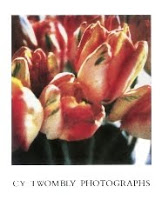 JTF (just the facts): Published in 1993 by Matthew Marks Gallery (here), in conjunction with an exhibition of the same name. Unpaginated, with 29 color images. Includes details on the portfolios/editions and a short essay by William Katz. The images were taken in Italy between 1984 and 1986 and printed between 1990 and 1994. The prints are grouped into portfolios, in editions of 10+2AP. (Cover shot at right, via Amazon.)
JTF (just the facts): Published in 1993 by Matthew Marks Gallery (here), in conjunction with an exhibition of the same name. Unpaginated, with 29 color images. Includes details on the portfolios/editions and a short essay by William Katz. The images were taken in Italy between 1984 and 1986 and printed between 1990 and 1994. The prints are grouped into portfolios, in editions of 10+2AP. (Cover shot at right, via Amazon.)
Auction Preview: Now: Art of the 21st Century, September 26, 2009 @Phillips London
Phillips is clearly continuing to fine tune its sales strategy, still looking for the right formula; the Saturday @Phillips sales appear to have been discontinued, replaced by this sale (catalog cover at right) and another focused on Latin America a week or so later.
This auction combines photography with other contemporary art and design, all from the last decade. There are a total of 112 photography lots on offer, with a total high estimate of £659500. As usual, Phillips has pushed the edge of the envelope with fresh material. One strange association: there’s a distinct echo of the Humble Arts Foundation’s Collector’s Guide (here) to be found amidst a grouping of these lots; many of the same artists and even the same specific prints have reappeared here. Also, it is interesting to see Helga Steppan and Jeongmee Yoon traveling down related roads. Of course, there’s lots of other new work from other sources as well.
Here’s the breakdown:
Total Low Lots (high estimate up to and including £5000): 78
Total Low Estimate (sum of high estimates of Low lots): £220000
Total Mid Lots (high estimate between £5000 and £25000): 31
Total Mid Estimate: £309500
Total High Lots (high estimate above £25000): 3
Total High Estimate: £130000
The top lot by High estimate is lot 141, Rashid Rana, When He Said I Do, He Did Not Say What He Did, 2004, at £40000-60000.
While there weren’t too many great fits for our collection, we did like lot 55 Stephen Gill, Billboard Series, 2004.
The complete lot by lot catalog can be found here.
Now: Art of the 21st Century
September 26th
Phillips De Pury & Company
Howick Place
London SW1P 1BB
UPDATE: So I’m not going crazy. Amani Olu has informed me that there is a formal collaboration going on between the Humble Arts Foundation and Phillips: 16 images were selected from The Collector’s Guide to Emerging Art Photography and included in the sale. The official announcement will come in the next week or so.
Permanent Collection Rehanging 2009 @MoMA
JTF (just the facts): Over 200 prints, installed in a series of 6 interconnected rooms, covering most of the history of the medium. The walls get lighter as the exhibition progresses. Details for each room can be found below, including artists represented and number of items on view. (Installation shots at right.)
Julien Vallon De Villeneuve (2)
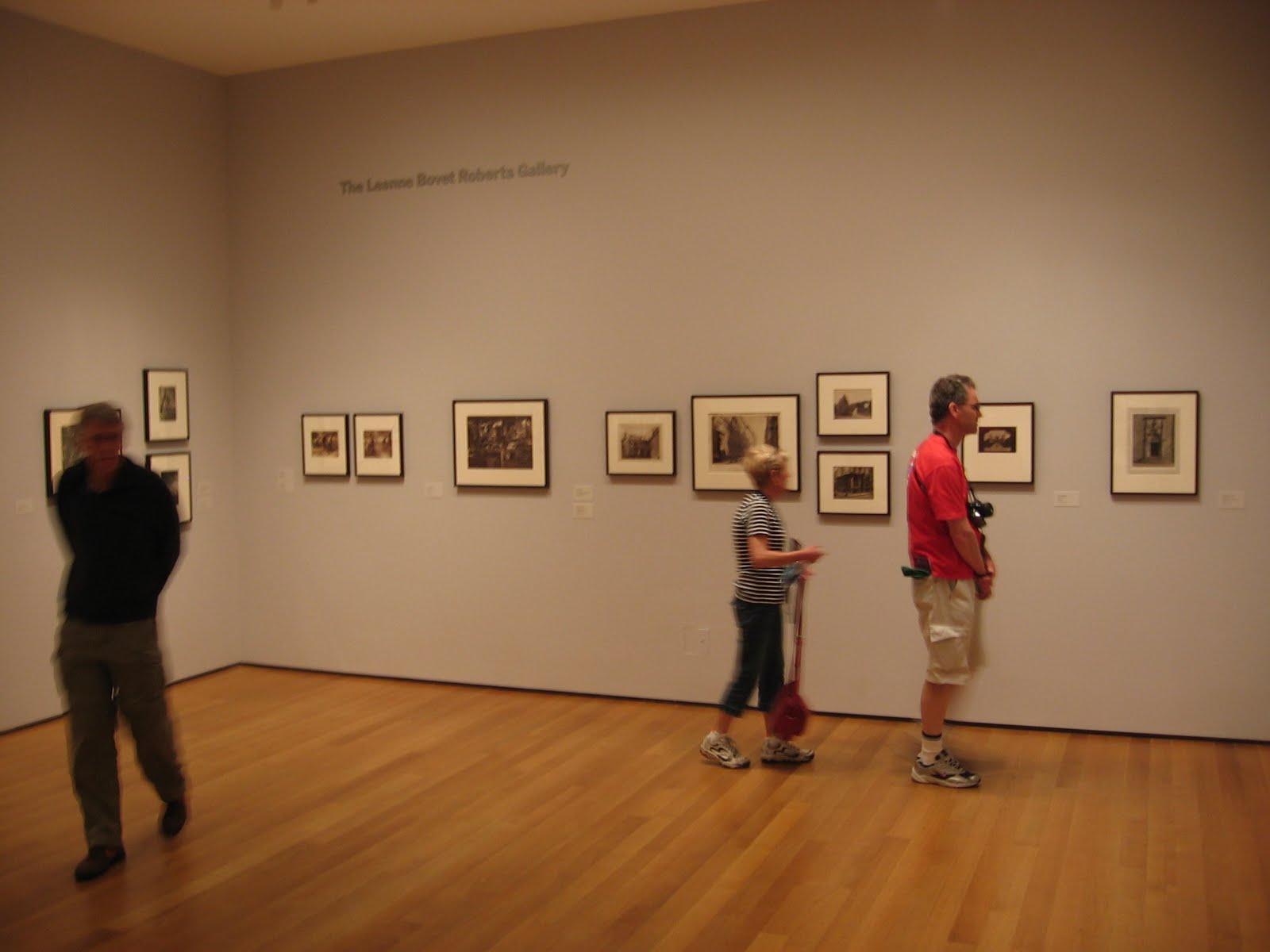 Room 3: a total of 32 prints, a mix of platinum, gelatin silver, photogravure, albumen, and carbon prints; ranging from 1875 to 1926.
Room 3: a total of 32 prints, a mix of platinum, gelatin silver, photogravure, albumen, and carbon prints; ranging from 1875 to 1926.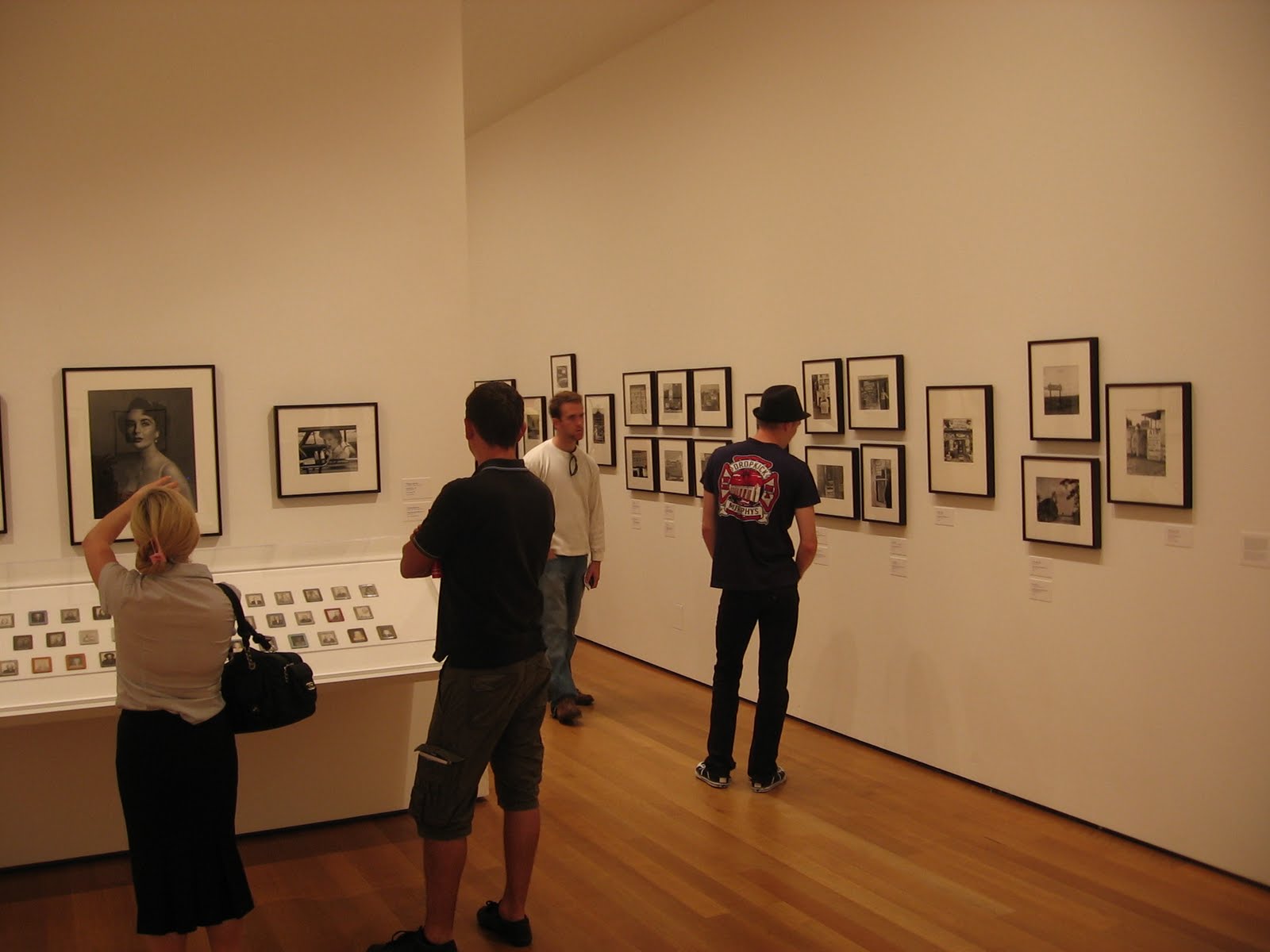 Room 4: a total of 61 images, plus 5 magazines, and 44 photobooth prints; ranging from 1920 to 1952.
Room 4: a total of 61 images, plus 5 magazines, and 44 photobooth prints; ranging from 1920 to 1952.
Lucien Aigner (1)
 Room 6: a total of 23 individual works, many with multiple prints.
Room 6: a total of 23 individual works, many with multiple prints.
Roy Arden (1)
Uta Barth (1 triptych)
Bernd and Hilla Becher (1 typology)
Richard Benson (6)
Thomas Demand (1)
Jane Hammond (1 framed group of images)
Sabine Hornig (1)
Louise Lawler (1)
Jerome Neuner (1 book)
Irving Penn (1)
Collier Schorr (1)
Steven Smith (2)
John Stezaeker (2)
Weng Fen (2)
Fred Wilson (1 wall with 26 images)
Comments/Context: Art world watchers from all over look carefully when the Museum of Modern Art in New York rehangs its permanent collection of painting and sculpture. They inspect each inclusion, discuss important omissions and consider what the curatorial decisions say about the reshaping of the narrative of Modern art. And while the Photography department at MoMA is equally dominant in its ability to lead the discussion about the history of its medium, the rehanging of the permanent collection each year seems like much less of an event that it should be. Why, I’m not quite sure.
This year’s rehang looks to have been an inside curatorial challenge of sorts: starting with recent acquisitions whenever possible, try to tell the story of photography through unexpected secondary pieces by well known photographers, mixed with relative unknowns, making a particular effort NOT to use any recognizable masterworks. (If it wasn’t designed to be the usual historical review but was merely a gathering of new acquisitions, it should have been marked more obviously as such.) For the crowd of folks who were streaming through the galleries when I was there, this seemed to be a confusing approach, leading to many puzzled looks, squinted wall label inspections, and aimless random wandering without any anchors to draw attention; everyone ended up in an eddy pool in front of the newly acquired Avedons.
The fourth room began with a group of European Modernists (one obscure but beautiful picture each), was followed by a long wall of FSA images, many using signs and painted text as the primary subject, and ended with a group of American Modernists and the transitionary figures of the late 1940s and 1950s. The Shaikhet gas tank, the Evans post office, and the Sommer glass abstractions were the standouts for me in this divided room.
The fifth room contained a group of 20 photographs by Richard Avedon (both portraits and fashion shots) as well as a mixed bag of secondary images from Arbus, Frank, Friedlander, Winogrand et al. The Avedons sucked all the air out of the room; all the people clustered looking at them (see image above), leaving the other side of the gallery deserted. The last room was the token contemporary room and the only one to contain any color. The Becher typology of framework houses was spectacular, and I also enjoyed the more subtle charms of the Barth triptych of flowers in a vase obscured by a shade; this final room was however only marginally representative of the reality of contemporary photography.
At some level, I certainly understand the desire to show new acqusitions and get some work out of storage that doesn’t get displayed much. But I’m not sure the “anti greatest hits” approach works very well for most of the audience. While we as collectors might be extremely interested in unusual prints, oddities, and lesser known discoveries, I think that most visitors will find this summary too haphazard and lacking in “the good stuff”. And perhaps this is the point: expose people to things they’re not expecting.
This selection of images does of course tell the chronological story of the medium (and does so with high quality prints from all periods); it therefore fulfills the educational requirement and mandate of any permanent collection exhibit. It also opens up some intriguing questions about the nature of the “masters” and their rightful place in telling the story of the medium; there are clearly many subcategories and alternate histories of photography that are possible. However, this isn’t a photography exhibit I would take our kids to; while there are certainly a handful of prints they might enjoy, I think the show is too random and untethered for them (there aren’t enough recognizable touch points); it seems built more for connoisseurs and experts who are drawn to the more irregular in photography, rather than for the general art viewer who is trying to make sense of it all and place it in the context of the entire sweep of art history. As such, I think it is a missed opportunity to make a more coherent case on behalf of the medium; I guess I have come to expect more leadership from MoMA, and didn’t get enough of it here.
Collector’s POV: I’ve already highlighted above our picks for the most exciting images in each room of the show. With a comprehensive museum group show like this one, the discussion of prices and markets for individual artists becomes unwieldy; suffice it to say that we could certainly choose a handful of images from this bunch that would fit well into our collection, although few of them would be on the very top of our hit list. To me, these works feel a little more like hole filling or deepening the collection, rather than striking out in new directions.
Rating: * (one star) GOOD (rating system described here)
Transit Hub:
Selections from the Permanent Collection
Through March 22
Museum of Modern Art
11 West 53rd Street
New York, NY 10019
Auction Preview: Contemporary Art, September 24, 2009 @Sotheby’s
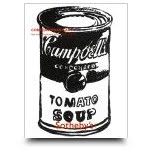 Sotheby’s is up second in the early Contemporary Art season, with its auction on September 24th. Like the sale Christie’s, this is a grab bag of mostly lower end material, with a few more surprises mixed in. There are a total of 34 photographic images on offer, with a total High estimate of $573000. (Catalog cover via Sotheby’s at right.)
Sotheby’s is up second in the early Contemporary Art season, with its auction on September 24th. Like the sale Christie’s, this is a grab bag of mostly lower end material, with a few more surprises mixed in. There are a total of 34 photographic images on offer, with a total High estimate of $573000. (Catalog cover via Sotheby’s at right.)
Here’s the breakdown:
Total Low lots (high estimate $10000 or lower): 20
Total Low estimate (sum of high estimates of Low lots): $150000
Total Mid lots (high estimate between $10000 and $50000): 12
Total Mid estimate: $288000
Total High lots (high estimate over $50000): 2
Total High estimate: $135000
Below is a list of the photographers who are represented (with the total number of prints for sale in parentheses):
Nobuyoshi Araki (1)
Vanessa Beecroft (1)
Oliver Boberg (1)
Mel Bochner (1)
Hans Breder (2)
Christopher Bucklow (1)
Eric Fischl (1)
Nan Goldin (1)
Dan Graham (2)
Alfredo Jaar (1)
Mike Kelley (1)
Anselm Kiefer (1)
Micha Klein (1)
Joseph Kosuth (1)
Louise Lawler (1)
Paul McCarthy (1)
Vik Muniz (2)
Jack Pierson (2)
David Robbins (1)
Michael Rovner (3)
Jenny Saville and Glen Luchford (2)
Thomas Struth (1)
Hiroshi Sugimoto (1)
Wolfgang Tillmans (1)
Ruud Van Empel (1)
Wang Qingsong (1)
Zhang Huan (1)
For our collection, lot 272 Dan Graham’s diptych Trucks, New York, NY and Row of Houses, Bayonne, NJ, 1966, would be the best fit. Given his current retrospective at the Whitney, there will likely be renewed interest in these early prints.
The lot by lot catalog can be found here. As an aside, the new Sotheby’s ecatalog format, while certainly beautiful, is quite unwieldy, so patience is required.
Contemporary Art
September 24th
Sotheby’s
1334 York Avenue
New York, NY 10021
Administrative note: We will be off on Monday for US Labor Day, back Tuesday. Thank goodness the summer photography drought is now over, so gallery shows, museum exhibits, and auction previews/results will take center stage once again, with photo book reviews resuming their normal place on Wednesdays.
Auction Preview: First Open Post-War and Contemporary Art, September 23, 2009 @Christie’s
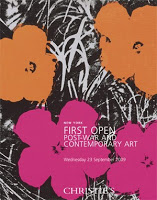 The fall auction season officially opens later in September with the warm-up Contemporary Art sales, beginning at Christie’s this cycle. There are a total of 20 photographic images on offer buried amidst the lower end material, with a total High estimate of $371000 on these lots. Given the relatively small number of total lots available, this will be a one session sale. (Catalog cover via Christie’s at right.)
The fall auction season officially opens later in September with the warm-up Contemporary Art sales, beginning at Christie’s this cycle. There are a total of 20 photographic images on offer buried amidst the lower end material, with a total High estimate of $371000 on these lots. Given the relatively small number of total lots available, this will be a one session sale. (Catalog cover via Christie’s at right.)
Here’s the breakdown:
Total Low lots (high estimate $10000 or lower): 4
Total Low estimate (sum of high estimates of Low lots): $31000
Total Mid lots (high estimate between $10000 and $50000): 15
Total Mid estimate: $280000
Total High lots (high estimate over $50000): 1
Total High estimate: $60000
Below is a list of the photographers who are represented (with the total number of prints for sale in parentheses):
Doug Aitken (1)
Darren Almond (1)
John Baldessari (1)
Matthew Barney (1)
John Bock (1)
Sante D’Orazio (1)
Elger Esser (2)
Vera Lutter (1)
Marilyn Minter (1)
Vik Muniz (1)
Shirin Neshat (1)
Gerhard Richter (2)
Thomas Ruff (1)
Cindy Sherman (2)
Sam Taylor Wood (3)
In general, this is a pretty average/uninspiring group; there aren’t many stand out photographs here. The Vera Lutter Untitled (Manhattan Skyline) from 1996 (lot 98) would be the best fit for our particular collection.
The lot by lot catalog can be found here.
First Open Post-War and Contemporary Art
September 23rd
Christie’s
20 Rockefeller Plaza
New York, NY 10020
Kehinde Wiley, Black Light @Deitch
 JTF (just the facts): A total of 16 photographs and 1 painting, hung in the main gallery, the entry and the side gallery spaces. The photographs are framed in brown wood and matted. 15 of the images are from the Black Light series (although only 14 are in the main space; I must have missed the other hung somewhere else). No dimensions were given, but they looked to be about 24×20. (Installation shots at right.)
JTF (just the facts): A total of 16 photographs and 1 painting, hung in the main gallery, the entry and the side gallery spaces. The photographs are framed in brown wood and matted. 15 of the images are from the Black Light series (although only 14 are in the main space; I must have missed the other hung somewhere else). No dimensions were given, but they looked to be about 24×20. (Installation shots at right.)
Comments/Context: Kehinde Wiley’s aggressively vibrant portraits of young African American men are an exercise in jarring juxtapositions, at once vaguely familiar and altogether different than anything we’re used to seeing. Drawing liberally from the canon of art history, he has borrowed poses and allegories from images of kings, noblemen and saints (those with status and power in society) and applied them to men from urban Hip Hop culture (those who have lacked such status and power to date): crowns and halos have been exchanged for flat brimmed baseball hats worn sideways; velvet cloaks and riding breeches have been traded for hoodies and oversized plaid shirts; elaborate jewelry is now an Etch-a-Sketch belt buckle; waxed mustaches have been replaced by scruffy beards and goatees. Quoting from 500 years of painting, Wiley has collapsed the typical boundaries and conventions of portraiture, using the visual language of the past to tell us compelling stories of the present.
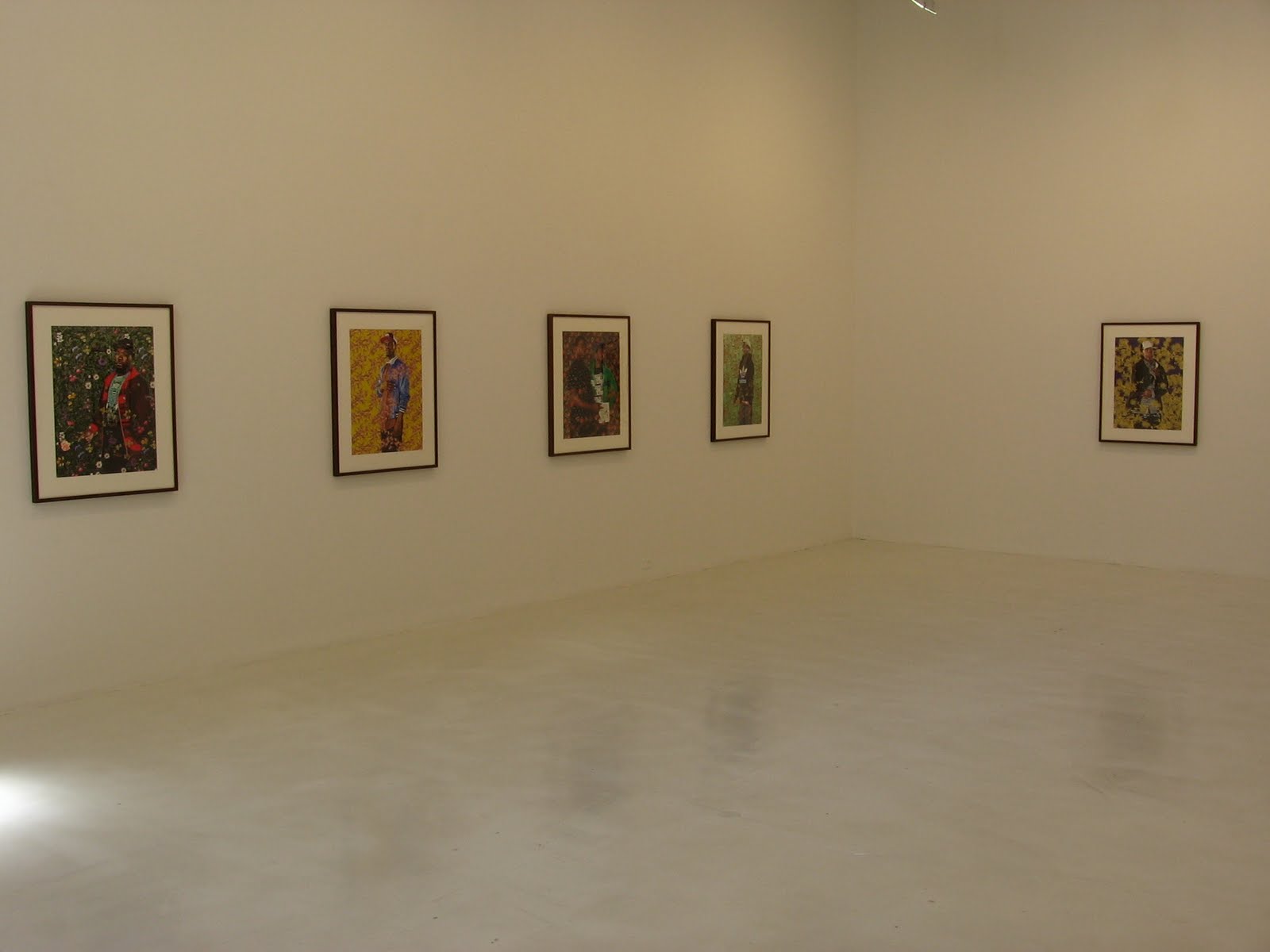 These pictures work not because of the witty references and tricky overlapping candy-colored Arts and Crafts floral wallpapers; the poses and backgrounds are simply tools that Wiley uses to carefully focus our attention on his subjects. It is their stories that he wants to tell; each one is given full confident attention, the contrast of the surroundings opening up subtler questions about the struggles and triumphs of young African American men in today’s world.
These pictures work not because of the witty references and tricky overlapping candy-colored Arts and Crafts floral wallpapers; the poses and backgrounds are simply tools that Wiley uses to carefully focus our attention on his subjects. It is their stories that he wants to tell; each one is given full confident attention, the contrast of the surroundings opening up subtler questions about the struggles and triumphs of young African American men in today’s world. Transit Hub:
- Artist website (here)
- New York magazine slideshow (here)
- Recognize! at the National Portrait Gallery (here)
- Interview with M.I.A. (here)
Kehinde Wiley, Black Light
Through September 26th
Photography Catalogues Raisonné
The Berenice Abbott 2 volume set we discussed yesterday got me thinking about catalogues raisonné and their availability in the world of photography. Catalogues raisonné require a huge amount of work to research, are expensive to produce, and have a generally limited market, so at some level, it’s not surprising that there aren’t more being published in any given year. For a medium like photography, where there are multiple copies of any single negative, the project is exponentially more complicated. But off the top of my head, I couldn’t come up with very many that were available.
So I went home and dug through our library and did some more thinking, and I’m sorry to say that I can’t come up with a single example of a true comprehensive catalogue raisonné for any photographer that matches those for any number of painters or sculptors. My definition here is every single image released as a finished object by the photographer (not the contact sheets and rejects), number of prints made of each, and exact dimensions. Trying to locate all the prints in public and private collections is beyond what seems achievable in most cases, although a few have tried.
The three below come the closest to meeting these standards, but in the end, they each only chronicle the holdings of a single museum, even though they may track down other prints of the same negatives in other places. The flaw is of course that if the issuing museum doesn’t hold a particular image, it isn’t in the book. Given these museums hold deep archives on the respective artists make this outlier effect pretty small, but I think it still matters.
- Amy Conger, Edward Weston: Photographs from the Collection of the Center for Creative Photography
- Sarah Greenough, Alfred Stieglitz, The Key Set (National Gallery of Art)
- Judith Keller, Walker Evans: The Getty Museum Collection
Beyond these three, there seem to be two additional potential substitutes: the deep monograph and the single subject volume.
In the deep monograph category, the books don’t attempt to be completely comprehensive, but do provide a generally thorough collection of key images. These books however lack the statistical information on number of prints made etc. I would place the Abbott set in this group (review here) as well as:
- The Work of Atget, Volume I-Old France, Volume II-The Art of Old Paris, Volume III-The Ancien Regime, Volume IV-Modern Times, MoMA
- Paul Strand, A Retrospective Monograph, Volume I-The Years 1915-1946; Volume II-The Years 1950-1968, Aperture
- Wolfgang Tillmans, If One Thing Matters Everything Matters, Tate Britain
In the single subject volume, the books go deep on one portion of a photographer’s output, often with some detailed background information. So we have Mapplethorpe’s flowers, but not his nudes, Sander’s portraits, but not his landscapes, and Brandt’s nudes, but not his pictures of Britain:
- Robert Mapplethorpe: The Complete Flowers, teNeues
- August Sander: People of the 20th Century (7 volume set), Abrams
- Brandt Nudes, Bill Brandt Archive
Our library is limited, so I’d really like the community at large to weigh in here with additional books that fit some of these definitions. You appraisers and auction house specialists must know of others that we have missed and that belong in the mythical perfect library. I imagine many estates know some of this information, but have yet to release it in book form for the public at large. And perhaps there is a dusty PhD thesis or two around that captures some of this information.
For a collector, the catalogue raisonné is the ultimate research tool; otherwise, we are left cobbling together a “virtual” catalogue from a shelf full of books on any specific photographer. I can’t believe that there aren’t plenty of master photographers who deserve the comprehensive treatment of such a volume (so book publishers, let’s see some more). Please, add your ideas and pointers to other catalogues raisonné of photography that we’ve missed in the comments, so we can all benefit.
Berenice Abbott (2 Volumes)
 JTF (just the facts): Published in 2008 by Steidl (here). 2 volumes, in a cloth slipcase. Volume I is 264 pages, with 118 black and white images, and includes essay by Ron Kurtz and Hank O’Neal. Volume II is 316 pages with 151 black and white images. (Cover shot at right, via Photo Eye.)
JTF (just the facts): Published in 2008 by Steidl (here). 2 volumes, in a cloth slipcase. Volume I is 264 pages, with 118 black and white images, and includes essay by Ron Kurtz and Hank O’Neal. Volume II is 316 pages with 151 black and white images. (Cover shot at right, via Photo Eye.)
Stanley Greenberg, Invisible New York
 JTF (just the facts): Published in 1998 by Johns Hopkins University Press (here). Subtitled The Hidden Infrastructure of the City. 100 pages, with 53 black and white images. Includes essays by Thomas Garver and the artist, as well as detailed plate by plate discussions of the locations and their histories. The images were taken between 1990 and 1997. (Cover shot at right, via artist website.)
JTF (just the facts): Published in 1998 by Johns Hopkins University Press (here). Subtitled The Hidden Infrastructure of the City. 100 pages, with 53 black and white images. Includes essays by Thomas Garver and the artist, as well as detailed plate by plate discussions of the locations and their histories. The images were taken between 1990 and 1997. (Cover shot at right, via artist website.)
Comments/Context: I was first introduced to Stanley Greenberg’s work in the back room of Tom Gitterman’s gallery a year or two ago, where a couple of the prints were hanging near the office area. Since then, I’ve been meaning to buy this book, so I could dig a little deeper on the work and see a larger number of images from the series.
Greenberg’s images chronicle the civic works and underworld utilities of New York, the often overlooked and hidden underbelly of non-places that keeps the city running. His subjects are bridge anchorings and construction shafts, electricity tunnels and water reservoirs, missile silos and rail yards, most of which have a throwback look of disrepair and decay. His compositions are full of intersecting found geometries (girders, trusses, turbines and the like) and long receding views down dimly lit, unpeopled, industrial tunnels. I think his densely packed interior scenes are the most successful.
To my eye, the work bears some relationship to both that of the Bechers and of Ray Mortenson. While Greenberg’s images are far warmer and more human that the rigorous typologies of the Bechers, I think they both share a conceptual desire to respectfully document vanishing (and important) vernacular architectural forms. The connection to Mortenson (and in particular to his images of the South Bronx) comes of course in the focus on decay and abandonment; both photographers effectively use their images to point out what happens when buildings fall into disuse and decline. I also see some more tenuous connections to the 1920s industrial work of Albert Renger–Patzsch, especially in Greenberg’s outdoor scenes.
All in, this is a solid book of unexpected photographs, well worth adding to your library.
Collector’s POV: Stanley Greenberg is represented in Gitterman Gallery in New York (here), Robert Klein Gallery in Boston (here), and Richard Levy Gallery in Albuquerque (here). Prints from this series are 28×36, in editions of 10. They are priced at $5000 each. No secondary market for Greenberg’s work has developed as yet, so gallery retail is the only option at the moment. While these works would normally fit perfectly into our city/industrial genre, once again we are constrained by size; these prints are just too big to fit easily into our display space without some tricky maneuvering. While the larger size certainly makes the images more dramatic, we’d need to see them printed 11×14 or so to make them work for us.
Transit Hub:
Course: Short Course on Chinese Contemporary Art @AW Asia
On four Tuesday nights in October, AW Asia (here) is putting on a free Short Course in Chinese Contemporary Art. Information on the course can be found here. The four sessions (an hour and a half each) include:
- From Mao to Now: An Overview of Chinese Contemporary Art
- Evening with Melissa Chiu, Director of the Asia Society and Museum
- Visit with Christopher Phillips, Curator ICP
- 21st Century China & the Global Art World
These look like excellent sessions for those of us who need to get better informed on contemporary photography in China. Registration is required.
Taliesin Thomas
Director, AW Asia
545 West 25th Street, Floor 7
New York, NY 10001
taliesin@awasiany.com
In a related note, Larry Warsh, the collector behind AW Asia, has recently sold groups of Chinese contemporary photography to both MoMA and the Getty. (here)
(via)
Photography in the Fall Previews
Two leading voices in the art world, Artforum and New York, published their Fall Previews of upcoming art exhibits this past week. While we already have a long list of good looking photo shows on our hit list, I was curious to see which photography exhibits in New York and elsewhere might be highlighted by these esteemed critics.
Artforum featured 50 exhibits worldwide in its September 2009 issue (the list is not yet available on their website, but it will eventually be here). To my eye, there was only one pure play photography exhibit in the list:
The Subversion of Images @Centre Pompidou (a survey of Surrealist photography)
There were six others that will include some terrific photography, but are not by definition really photography exhibits:
Gabriel Orozco @MoMA
Bauhaus 1919-1933: Workshops for Modernity @MoMA
Alias Man Ray: The Art of Reinvention @Jewish Museum
Gordon Matta-Clark @Museo Nacional De Bellas Artes
John Baldessari @Tate Modern
Lázló Moholy-Nagy @Schirn Kunstahalle
Jerry Saltz of New York magazine selected 15 exhibits for his list of “Want-to-Sees” (his whole list can be found here). Only one is a pure play photography exhibit:
Justine Kurland @Mitchell-Innes & Nash
A second falls into the sort-of photography camp:
Sarah Anne Johnson: House on Fire @Julie Saul
In many ways, these two lists left me scratching my head: these shows are the best and most interesting of what the entire world of photography has to offer this fall? Seriously? And then I looked back to my own exhaustive list of photo shows coming up in New York, and there seem to be plenty that seem likely to be exciting or startling, including Sally Mann, Jeff Wall, and Nicholas Nixon, among quite a few others of interest. So where’s the disconnect?
The point of this post is not to bellyache about the sad state of photography criticism (I’ve done that plenty already). While it might be easy to find fault with the critics, I actually think the onus falls back on the gallery owners and museum curators to rectify the problem of photography’s low profile. The crucial issue is that much of contemporary photography does not seem to be being recognized by the wider audience at large as relevant to the bigger art world issues of the day; unfortunately, we’re still in a corner talking to ourselves and few are looking to us to be leaders.
The only way out of this trap is excellence. If we want attention for the photographers that we feel deserve better recognition, we must have a deeper roster of world class museum exhibitions and gallery shows that bring this photography to the forefront and we need to do a better job of making the case to the public that they’re important. So rather than mutter that these critics are out of touch with photography, I think a better reaction to these Fall Previews is that as a community, we need to redouble our efforts to deliver the spine tingling excellence that the market requires.
UPDATE: Artnet magazine recently posted its Top Twenty Shows (here). There were four photography inclusions:
Irving Penn: Small Trades @Getty
Common Ground: Eight Philadelphia Photographers in the 1960s and 1970s @Philadelphia Museum of Art
The Provoke Era: Postwar Japanese Photography @SFMOMA
On the Scene: Jason Lazarus, Wolfgang Plöger, Zoe Strauss @Art Institute of Chicago
It’s interesting to note that in terms of photography, there was no overlap with the Artforum choices.
Auction Preview: Photographies, Mobilier et Objects D’Art, September 23, 2009 @Sotheby’s Paris
 While the main photography auction season in New York doesn’t really being until early October, a few sales are starting to pop up to remind us that summer is nearly over. Coming up in September, Sotheby’s Paris is auctioning off an entire apartment of stuff, including a total of 65 photographs, with a total High estimate of 409200€ on the photography alone. (Catalog cover at right.)
While the main photography auction season in New York doesn’t really being until early October, a few sales are starting to pop up to remind us that summer is nearly over. Coming up in September, Sotheby’s Paris is auctioning off an entire apartment of stuff, including a total of 65 photographs, with a total High estimate of 409200€ on the photography alone. (Catalog cover at right.)
.
Ansel Adams (3)
Manuel Álvarez Bravo (2)
Cecil Beaton (1)
Margaret Bourke-White (1)
Serge Bramly (1)
Henri Cartier-Bresson (2)
Imogen Cunningham (1)
Lynn Davis (1)
Leah Demchick (1)
Walker Evans (1)
Adolf Fassbender (1)
Andreas Feininger (3)
Arnold Genthe (1)
Hélène Guétary (2)
Art Kane (2)
André Kertész (3)
Marion Lachaise (1)
Marcus Leatherdale (5)
Peter Lindbergh (1)
Robert Mapplethorpe (1)
Mary Ellen Mark (4)
Sergej Maximishin (1)
William Mortensen (2)
Vik Muniz (1)
Irving Penn (2)
Man Ray (1)
Bettina Rheims (1)
Wynn Richards (1)
Herb Ritts (3)
Sebastião Salgado (1)
W. Eugene Smith (1)
Albert Steiner (1)
Hiroshi Sugimoto (5)
André Villers (2)
Bruce Weber (2)
Ray Charles White (1)
May Yavno (1)
At some point soon, I imagine the sale catalog will find its way to the Internet, and will be found at the link below.

